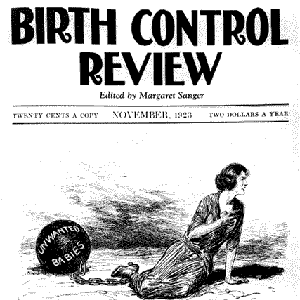Margaret Sanger

"To have ethos is to manifest the virtues most valued by the culture to and for which one speaks—in Athens: justice, courage, temperance, magnificence, magnanimity, liberality, gentleness, prudence, wisdom." (Halloran, 1982, p. 60)
In Buchanan's second and longest chapter, "From 'Wild Woman Writer' to 'Mother of Two': Margaret Sanger, Birth Control, and Ethos Repair," she focused her first case study on very crucial years (1914–1917) in Margaret Sanger's life. This specific focus supports the claim Buchanan's Woman/Mother continuum presents.
It is within this chapter that Buchanan delivered the strongest claim for the power of the rhetoric of motherhood.
Buchanan focused on the benefits that may befall women who employ maternal appeals effectively in public discourse (p. 27). Buchanan started the chapter describing Sanger's public image in 1914 and the major events and publications that influenced society to view her negatively, as a rebel woman—Sanger's militant, feminist paper, Woman Rebel, was founded that year with the masthead "No Gods, No Masters" (p. 24). Sanger was trying to address and pursue a great number of issues present for women during that time period, but she wasn't moving in a positive direction. Even though she was a nurse and a mother, and working only to help other women she saw as needing support and education, she received negative media attention and federal authorities were not in support of her rhetoric and course of action. This, Buchanan argues, was because she was seen as a woman only, and not as a mother.
After returning from a one year exile to repair her public image, Sanger directed all of her attention on the one topic she found most important—birth control. Buchanan acknowledged and reinforced that initially Sanger was unable to represent all mothers equally and it was not until she produced her film in 1917 that she presented motherhood as an experience that aligned women across class lines (p. 47). Sanger evolved by using the rhetoric of motherhood from being viewed as the "devil-term, woman" to the "god-term, mother." Sanger "aligned contraception with motherhood, transforming its radical, immoral associations into righteous, respectable ones" (p. 26). Motherhood not only allowed Sanger "to repair and reformulate her own damaged ethos" but also "to discover 'universal' grounds for women's identification and affiliation" (p. 62). This, Buchanan argues, was done purposefully; Sanger recognized that without her motherhood ethos, she probably would not have been as successful in pressing for changes for other pregnant women.
Buchanan's choice to use Sanger as the first of her case studies represents the influence society and the media have on how a woman can be viewed negatively. Sanger's social and public images were greatly impacted by how society first viewed her negatively as a woman and then how much that positively shifted when she was viewed as a mother; the evidence from the case study supports Buchanan's continuum. Readers will learn in this case chapter that when employed purposely, the rhetoric of motherhood will attract the audience it sets out to gain.